How Google Earth is helping develop native plants

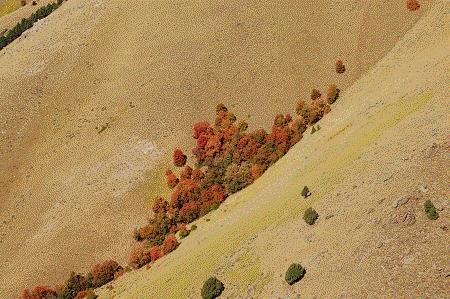
Smithfield Canyon at peak fall color from Google Earth, top, and an aerial from an airplane, bottom.
When Larry Rupp at Utah State University set out to help develop selections of Intermountain native plants that hort producers could get excited about, he turned to Google Earth.
Using Google Earth at the height of fall color in the Utah mountains, he was able to identify wild individuals of Acer saccharum ssp. grandidentatum with superior red foliage. Those remote searches complemented the word-of-mouth referrals he received on superior individuals.
Acer saccharum ssp. grandidentatum, a.k.a. bigtooth maple, has never really captured the public’s attention. It’s slow growing and hard to cultivate in a nursery. Horticultural selections have only recently been offered. Production blocks of straight species show high degrees of variability. When plants are so variable, it’s hard for the industry to market the plants or landscape architects to be able to count on landscape size performance, he said.
To increase the number of natives in the modern landscape, the plant industry has to engage, Larry said in a webinar about the project. Plant producers must be able to both grow and sell the plants.
Based on those Google Earth searches and aerial photography, he collected scion wood of promising accessions in the wild and began the process of determining the most effective means of local propagation. In collaboration with J. Frank Schmidt Nursery, he also began evaluating commercial production and landscape performance.
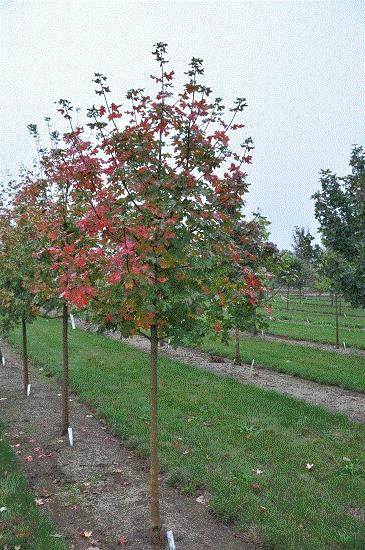
USU-ACGR-1005 in the field.
Currently USU-ACGR-1005 is being commercially tested. Plants show a tight crown that should benefit suburban landscapes where space is more limited and gorgeous red fall color.
Thank you to J. Frank Schmidt Nursery for helping to fund the project.
See and hear more of the story yourself: Selection and Propagation of Native Woody Plants for the Intermountain Area, part of Utah State University’s Extension Forestry’s monthly webinar series.
___________________________________________________

Hort employers: The environment matters to prospective employees
Want to attract talent? Play up how your company helps the environment to potential employees.
According to the results of a student survey by Jim Hansel—who teaches horticulture at a Career Center in Cincinnati, as well as horticulture/agriculture at the University of Cincinnati—doing environmental good is one of the drivers of today’s students.
When recruiting students trained in horticulture, you can gain an edge by presenting how your company helps the environment. Competitive wages are a given in order to keep skilled employees, but you very well might gain an edge in attracting top talent by promoting the things you do to make the environment a better place.
Highlight the daily activities your company does, like composting, recycling plastic waste, employing IPM/organic land care, etc. Many of today’s young people want to know their employers care about the amount of plastic and other waste, noise and air pollution, nutrient runoff, and harm/benefit to wildlife that business operations can cause. They want to work to actively benefit the environment.
“Help the environment” was a top reason for why students want to work with plants when survey responses were pooled for Ohio students in the ag/hort programs at the University of Cincinnati, Cincinnati State Technical College and Great Oaks District. “Create beautiful landscapes” was a close second.
Students are most interested in careers in landscape architecture and design, food production and greenhouse/nursery production. They say they offer employers “a desire to learn new things,” “creative ideas” and a “get-the-job-done attitude.”
If you’re interested in learning more, you can reach Jim at HanselJ@greatoaks.com.
___________________________________________________

Protect tree infiltration functionality with guards
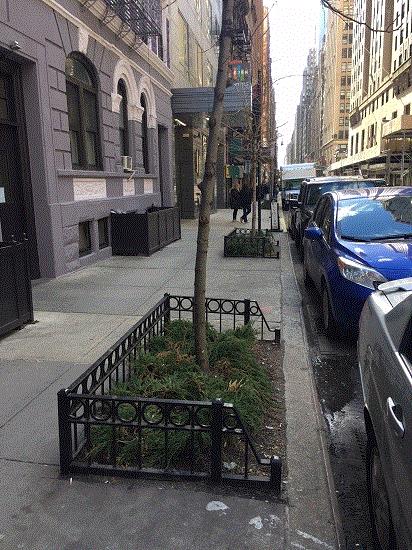
When tree guards are used around street trees in New York City, stormwater runoff to the city’s sewers is reduced. New York City trees protected with tree guards soak up runoff water six times faster than trees without guards. That could benefit New York’s combined sewer system and reduce overflows of raw sewage into surface waters during storm events.
Comparing the infiltration rate of street trees with and without guards in Manhattan’s Morningside Heights neighborhood, Columbia University researchers found that trees in protected pits absorbed water six times faster on average than tree pits without guards—3 millimeters vs. 0.5 millimeters per minute. Tree guards protect trees from pedestrian traffic that can compact soil. The researchers believe protected soils absorbed runoff more quickly.
The effects of mulch and groundcover was also studied. But neither made much difference compared to tree guards. City-recommended tree guards cost about $1,000, depending on their style and size of the tree pit, but an improvised $20 fence can work just as well, said the study’s lead author Robert Elliott, a recent graduate of Columbia Engineering and cofounder of Urban Leaf, in a Columbia University blog post.
Unpublished work looked at the costs and benefits of trees with guards compared to bioswale. What they found is that bioswales outperform trees with guards when looking at the initial cost and maintenance over 10 years; bioswales captured 141,886 gal./per year at $0.20/gal., compared to a guarded tree pit’s extra 1,132 gal. per year at $0.49/gal.
But trees can be competitive if the cost of guards is reduced or water flows are increased by curb cuts, so stormwater can flow in from the street. Trees may also be less controversial. Some residents in some NYC Burroughs have complained about “ugly” bioswales the city has installed.
—Condensed from So Much Depends on a Tree Guard by Kim Martineau, Columbia University.
Stormwater infiltration capacity of street tree pits: Quantifying the influence of different design and management strategies in New York City by Robert Elliott, Elizabeth Adkins, Patricia Culligan and Matthew Palmer in Ecological Engineering (open access).
_____________________________________________________

Pollinator Week: June 18-24, 2018
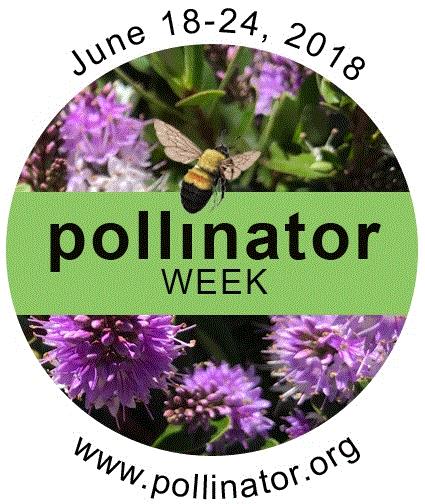
The Pollinator Partnership has announced that Pollinator Week will be held from June 18-24, 2018. If you’ve got events to publicize, visit Pollinator Partnership to add them to the national map. In case you missed it, they’ve got a great Monarch Highway 2017 poster for sale.
__________________________________________________________________
20% more trees in megacities would double urban forest benefits
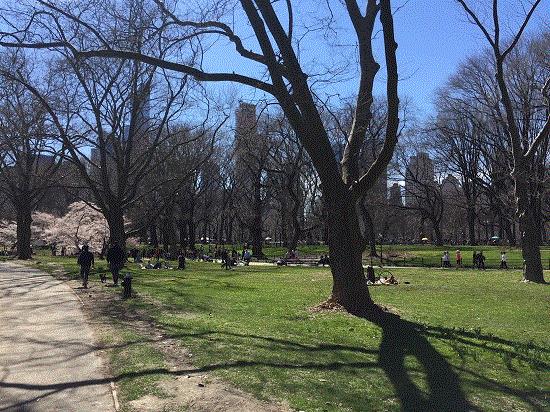
Central Park in New York City is one of 20 locations modeled in a study about urban forest ecosystems services in megacities.
Just 20% more trees would help to clean more air and water, and lower energy use and the carbon footprint of world megacities (cities with at least 10 million people).
The authors of “Implementing and managing urban forests: A much needed conservation strategy to increase ecosystem services and urban wellbeing,” a modeling study published in Ecological Modeling, predict that just 20% more trees in megacities would double the benefits of urban forests and that city planners, residents and other stakeholders should look within cities to conserve and increase nature by keeping and planting more trees.
The study, conducted by Parthenope University of Naples in Italy, included many examples of urban forests in megacities, from Central Park in New York City to St. James' Park in London and Bosque de Chapultepec in Mexico City.
When the study team used i-Tree Canopy to estimate the current tree coverage and the potential for more urban forest cover in 10 megacities, they learned that each city could accommodate an additional 20% of canopy coverage. i-Tree estimates that the current benefits of the urban forests in those cities is valued at about $500 million/year.
On average, about 20% of the area of each of the world's megacities is urban forest today. The less cities rely on nature outside the metropolitan area and the more they focus on conserving nature within the cities, the healthier and more sustainable those cities will be.
—Condensed from “20 percent more trees in megacities would mean cleaner air and water, lower carbon and energy use,” a release by Elsevier.
Implementing and managing urban forests: A much needed conservation strategy to increase ecosystem services and urban wellbeing by T. Endreny, R. Santagata, A. Perna, C. De Stefano, R.F. Rallo, and S. Ulgiati in Ecological Modelling (open access).
_____________________________________________________________________________________

UW-M Arboretum latest Monarch Joint Venture partner

The Arboretum at the University of Wisconsin–Madison is the latest partner to join the Monarch Joint Venture (MJV) conservation initiative. MJV coordinates more than 70 partners by helping them establish pollinator-friendly habitat, provide educational resources and identify threats to Monarch populations.
The Arboretum at UW-Madison is the first arboretum to partner with the MJV. Arboretum director Karen Oberhauser, a leading Monarch researcher, co-founded the MJV while at the University of Minnesota and is currently co-chair of the venture’s steering committee.
“It’s a perfect partnership; the Arboretum works on all areas of the MJV’s conservation plan with our conservation education programs, habitat conservation actions and research,” she says. “When we preserve habitat for Monarchs and educate people about what they can do for Monarchs, we’re really doing things for a lot of other species at the same time.”
—UW Arboretum joins the Monarch Joint Venture by Eric Hamilton for the University of Wisconsin-Madison.
_____________________________________________________________________________________
Experiential, Eco-Friendly—NALP’s Top 2018 Landscape Trends

The National Association of Landscape Professionals (NALP) announced its official list of the top landscape trends of 2018.
NALP predicts the following five trends to influence landscape planning and design in 2018:
-
Experiential landscape design. Today’s landscapes are built for living, working and playing. Office landscapes more frequently include walking and bicycle paths, dining areas or gardens to enhance employee experience.
-
Climate-cognizant landscaping. Unpredictable weather patterns necessitate landscape enhancements that withstand extreme conditions and allow spaces to be enjoyed on unseasonably cool or warm days.
-
Emphasis on water management and conservation. The integration of eco-friendly watering practices are expected to continue to take off in 2018, including the use of plants native to a region (which generally use less water), xeriscaping (planning a landscape to use low-water use plants) and smart irrigation technology.
-
Enhanced equipment and technology. Many lawn mowers, leaf blowers and similar equipment feature low or no emissions, are battery-powered and are quieter.
-
Plants in playful colors and patterns. With ultra violet named the Color of the Year by Pantone, landscape professionals expect to integrate more violets, verbena, clematis, iris and other purple flowers into landscapes.
NALP represents an industry that employs nearly 1 million landscape, lawn care, irrigation and tree care professionals who create and maintain healthy green spaces for the benefit of society and the environment.
_____________________________________________________________________________________
Correction
Events
February 2018: Organic Land Care Certificate (NJ)
Introduction to Organic Land Care-Certificate Course is a four-day training offered by Rutgers Cooperative Extension of Monmouth County. Dates are February 5, 6, 12 and 13. More than 20 university and industry experts teach the course and share their experience of how to successfully transition a landscape to organic management and add organic services to a business. The course focuses on organic practices for promoting healthy soil, enhancing biodiversity and reducing polluted runoff from managed landscapes. The course is designed for professional landscapers, property managers, public works employees, groundskeepers, landscape architects and Rutgers Master Gardeners.
February 10/June 14: River-Friendly Green Gardener (CA)
The half-day course Integrated Pest Management II: An Advanced Perspective is back by popular demand. The program will be offered twice at different times and days—February 10 at the La Sierra Community Center in Carmichael and June 14 at the Folsom Community Center in Folsom. Instructor Steve Zien will go beyond the basics to discuss landscape pest identification (including new species) key strategies to prevent pests and management options from cultural controls to pesticides.
The seminar will focus on Holistic Pest Management, which acknowledges that plants and their pests function in a shared ecological-system. You'll learn how to keep this system in balance and discourage pests before they get out of hand.
February 6-9: NOFA Organic Land Care (CT)
The NOFA Organic Land Care curriculum is based on NOFA’s Standards for Land Care: Practices for Design and Maintenance of Ecological Landscapes and includes 30 hours of instruction over four days. The course has been designed for professionals with five years of experience. At the end of the program, students may take an exam to become an Accredited Organic Land Care Professional. Questions? Call (203) 308-2584 or email jeremy@ctnofa.org.
February 21-22: Urban Green Infrastructure Summit (WA)
The Western Center for Metropolitan Extension & Research at Washington State University is conducting an Urban Green Infrastructure Summit at the Embassy Suites in Tigard, Oregon, on February 21 and 22. This summit will connect government and agency personnel, university researchers and extension professionals to create new collaborative networks, identify research and education priorities, and share existing resources.
February 22-23: 2018 Land & Water Summit (NM)
The Ripple Effect: Stormwater & Tree Canopy is the theme for the 2018 Land & Water Summit sponsored by the Xeriscape Council of New Mexico to be held in Albuquerque, New Mexico, at the Albuquerque Airport Sheraton. The opening keynote, “Climate Resilience: A new paradigm of change,” will be delivered by Mike McMahon, HDR Engineering.
February 23 Green Matters: Restoring Our Urban Landscapes (MD)
How can we design our landscapes in ways that prevent harm to existing ecosystems and regenerate the environment? Join Green Matters, an annual symposium sponsored by Brookside Gardens, that concentrates attention on the intersection of horticulture and environmental issues. This year’s event, Restoring Our Urban Landscapes, will be held at the Silver Spring Civic Building in Silver Spring. Talks are to include: "Biophillic Urbanism: A New Approach for Creating Sustainable Environments" by Dr. Timothy Beatley and Teresa Heinz, University of Virginia; "Creating Healthy Soils Through Regenerative Gardening Practices" by Jeff Lowenfels, author and columnist; "Habitat Matters: Restoring Ecosystem Functionality & Biodiversity" by Heather Holm, horticulturist, biologist, writer and landscape designer; and "Lessons In Landscape Design: Integrating Natural Systems into the Built Environment" by Kate Hayes, Associate, SCAPE Landscape Architecture DPC.
March 2-3: Ithaca Native Landscape Symposium (NY)
Learn about native plants in the wild and their roles in sustainable landscapes at the 10th annual Ithaca Native Landscape Symposium at the Cinemapolis Theater in Ithaca, New York. The topics to be covered include: “Native Plant Responses to Climate Change in Cornell’s Mundy Wildflower Garden: Thirty Years of Data!”; “Planting in a Post-Wild World;” “Designing Dynamic Native Landscapes;” “Maintaining Dynamic Native Landscapes;” and “Rain Gardens and Shoreline Buffers,” among others.
March 7-8: 24th Annual ELA Conference& Eco-Marketplace (MA)
Join the Ecological Landscape Alliance for their two-day Conference & Eco-Marketplace in Amherst, Massachusetts. Wednesday, March 7th will have two concurrent day-long sessions focusing on "Designing for Carbon Sequestration and Ecological Methods of Maximizing Landscape Productivity and Potential." The day will conclude with dinner and a keynote address, "Landscape Design as Ecological Art," by landscape architect Darrel Morrison, FASLA. Thursday, March 8th includes concurrent workshops covering a variety of topics, including restoring urban habitat, permaculture approaches to managing invasive species and designing with the wild in mind. The day will also include two panel discussions, a talk and demonstration on seeding and propagating native plants, and a tour of the landscape for the UMass Design Building, recently constructed and considered a model of ecological design.
March 16: Greening Urban Childhood by Design (NC)
The 11th Annual Growing in Place Symposium, Greening Urban Childhood by Design, will be held at the North Carolina Museum of Natural Sciences in Raleigh. The theme, "Urban Nature by Design," will cover topics such as “Applying biophilic design to restore biodiversity to cities;” “Planning urban green/blue infrastructure to engage children and families;” “Managing urban habitats to maximize play and learning opportunities;” and “Ensuring culturally equitable nature experiences.” The event is geared to public/private sector practitioners, landscape architects, architects, planners, parks and recreation professionals, teachers and environmental educators and elected officials.
Now Online—Making Urban Trees Count: Quantifying and crediting stormwater benefits
Making Urban Trees Count: Quantifying and crediting stormwater benefits is now available for online viewing. In this webinar, Karen Cappiella, Center for Watershed Protection, and Justin Hynicka, American Forests, will review the available stormwater crediting systems for urban tree planting and will present a new crediting system that can be integrated into state and local compliance systems for stormwater management, Total Maximum Daily Loads (TMDLs) and other water quality requirements. The presenters share a case study example of how this crediting framework has been formally adopted by state and federal agencies in the Chesapeake Bay TMDL area, which covers 64,000 square miles across six states and D.C.
____________________________________________________________________________________
Worth reading
Best,

Debbie Hamrick
NewTerrain
This email was received by 18,594 readers.
If you're interested in advertising in NewTerrain, contact Kim Brown.